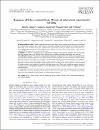Responses of lichen communities to 18 years of natural and experimental warming
| Author | Alatalo, Juha M. |
| Author | Jägerbrand, Annika K. |
| Author | Chen, Shengbin |
| Author | Molau, Ulf |
| Available date | 2021-01-27T11:06:56Z |
| Publication Date | 2017 |
| Publication Name | Annals of Botany |
| Resource | Scopus |
| ISSN | 3057364 |
| Abstract | Background and Aims Climate change is expected to have major impacts on high alpine and arctic ecosystems in the future, but empirical data on the impact of long-term warming on lichen diversity and richness are sparse. This study report the effects of 18 years of ambient and experimental warming on lichens and vascular plant cover in two alpine plant communities, a dry heath with sparse canopy cover (54 %) and a mesic meadow with a more developed (67 %) canopy cover, in sub-arctic Sweden. Methods The effects of long-term passive experimental warming using open top chambers (OTCs) on lichens and total vascular plant cover, and the impact of plant cover on lichen community parameters, were analysed. Key Results Between 1993 and 2013, mean annual temperature increased about 2 °C. Both site and experimental warming had a significant effect on cover, species richness, effective number of species evenness of lichens, and total plant canopy cover. Lichen cover increased in the heath under ambient conditions, and remained more stable under experimental warming. The negative effect on species richness and effective number of species was driven by a decrease in lichens under experimental warming in the meadow. Lichen cover, species richness, effective number of species evenness were negatively correlated with plant canopy cover. There was a significant negative impact on one species and a non-significant tendency of lower abundance of the most common species in response to experimental warming. Conclusions The results from the long-term warming study imply that arctic and high alpine lichen communities are likely to be negatively affected by climate change and an increase in plant canopy cover. Both biotic and abiotic factors are thus important for future impacts of climate change on lichens. |
| Language | en |
| Publisher | Oxford University Press |
| Subject | Arctic climate change effective number of species global warming plant-climate interactions species richness tundra |
| Type | Article |
| Pagination | 159-170 |
| Issue Number | 1 |
| Volume Number | 120 |
Files in this item
This item appears in the following Collection(s)
-
Biological & Environmental Sciences [940 items ]


